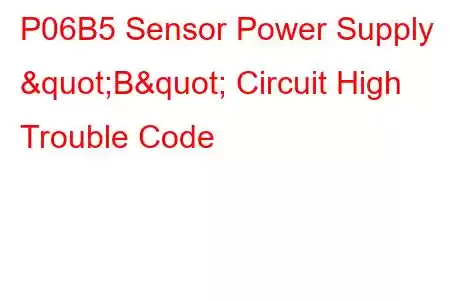P06B5 Sensor Power Supply B Circuit High
OBD-II Trouble Code Technical Description
Sensor Power Supply B Circuit High
What does that mean?
This is a generic diagnostic trouble code (DTC) and applies to many OBD-II vehicles (1996-newer). That may include but is not limited to vehicles from Buick, Chevrolet, Chrysler, Fiat, Ford, GMC, and Mercedes-Benz, etc. Although generic, the exact repair steps may vary depending on year, make, model and powertrain configuration.
When an OBD-II equipped vehicle has stored a code P06B5, it means that the powertrain control module (PCM) has detected a level of voltage that exceeds maximum parameters for a particular sensor or group of sensors. Depending upon manufacturer. the sensor (or sensors) in question may be related to the exhaust gas recirculation system, the heated exhaust oxygen sensor system, the automatic transmission, or the transfer case (four-wheel drive or all-wheel drive vehicles only).The sensor circuit affected has been given the designation B (A & B may be interchanged as well).
Most OBD-II sensors are activated by a voltage signal that is provided by the PCM or one of the other on-board controllers. The degree of voltage applied (frequently called reference voltage) may vary between very low voltage (typically measured in millivolts) up to full battery voltage. The most common sensor voltage signal is 5-volts; followed closely by battery voltage. Obviously, you will need to determine exactly which sensor is related to this code. A reliable source of vehicle information will yield this information.
If the PCM (or any of the other on-board controllers) detects a degree of voltage which exceeds maximum parameters on the power supply circuit designated B, the code P06B5 may be stored and a service engine soon/malfunction indicator lamp (SES/MIL) illuminated. SES/MIL illumination may require multiple ignition cycles with a failure.
A typical PCM powertrain control module, opened up:
What is the severity of this DTC?
I would certainly categorize this code as severe. Its wide reaching sensor inclusion makes it difficult - if not impossible - to pinpoint precisely how catastrophic the symptoms of the condition which has contributed to the P06B5 code being stored could prove.
What are some of the symptoms of the code?
Symptoms of a P06B5 trouble code may include:
Transfer case is inoperative Engine no-start condition Diminished fuel efficiency Engine hesitation, sag, miss, or stumble Serious engine drivability issues Transmission may shift erratically Transmission may shift harshlyWhat are some of the common causes of the code?
Causes for this code may include:
Defective engine, transmission, or transfer case sensor Blown fuse or fusible link Open or shorted wiring and/or connectors or grounds PCM failure or a PCM programming errorWhat are some P06B5 troubleshooting steps?
Diagnose and repair any other sensor related codes prior to attempting a diagnosis for the stored P06B5.
To accurately diagnose a code P06B5, you will need a diagnostic scanner, a digital volt/ohmmeter (DVOM), and a source of reliable vehicle information.
Without means to reprogram controllers, reaching an accurate diagnostic conclusion for the stored P06B5 will be challenging at best. You may save yourself some headaches by searching for technical service bulletins (TSB) that replicate the code stored, vehicle (year, make, model, and engine), and symptoms exhibited. This information may be found in your vehicle information source. If you succeed in locating the appropriate TSB, it could yield very helpful diagnostic information.
Connect the scanner to the vehicle diagnostic port and retrieve all stored codes and pertinent freeze frame data. After you write this information down (in case the code proves to be an intermittent one) clear the co
Read: 34


